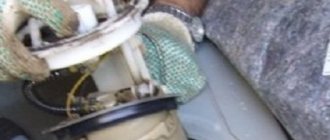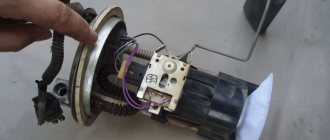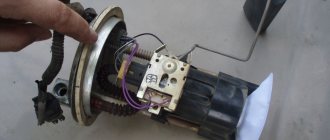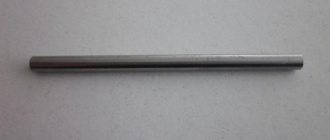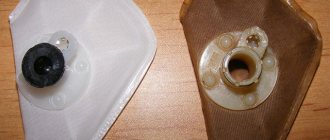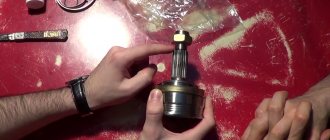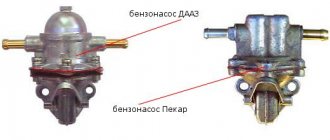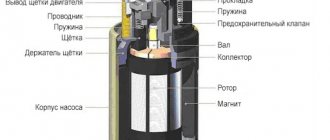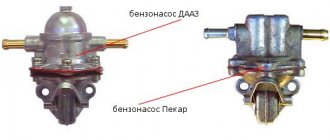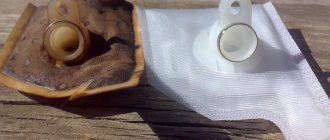The question of how to remove the fuel pump on Lada Kalina cars can often be found on the World Wide Web. But the thing is that the quality of our gasoline and the ability for stable operation of this part cannot “get along” in a peaceful environment. Therefore, the need for a complete replacement or repair of this device for owners of Lada Kalina occurs with enviable frequency.
In the video, replacing the fuel pump on a Lada Kalina:
Replacing the fuel pump
To access the Lada Kalina fuel pump, you need to fold back the rear seat, remove the insulation (if any), and then begin dismantling the device.
Tool for the job
- Screwdriver with flat and Phillips blade.
- Hammer.
- Pliers.
Step-by-step work order
- Disconnect the negative terminal from the battery.
- We open access to the protective cover.
To avoid losing, we put the bolts in one place.
Under the decorative cover you can see the fuel pump and DUST!
The block is marked with a red arrow, and the fittings with a green arrow.
Strikes should only be made on the ring.
Successfully dismantled fuel pump.
Replacing the fuel pump mesh
Fuel pump mesh close up
When the fuel pump is removed, you can inspect the filter mesh. This is the so-called coarse filter. To do this, you need to disassemble the fuel pump and replace the filter element.
On the left is the new one, on the right is the old fuel pump mesh.
conclusions
All of the instructions described above are designed so that even the most unprepared car enthusiast can independently remove the fuel pump on his Lada Kalina; the most important thing is not to rush, do everything consistently and carefully!
The Lada-Kalina submersible fuel pump, as in other cars, is necessary to supply gasoline to the combustion chamber of the internal combustion engine. The pump is activated immediately when the ignition is turned on and maintains operating pressure until the car is turned off or the fuel runs out. The fuel pump is part of a module that includes a fuel pressure regulator, which changes the supply parameters when the driver operates the accelerator pedal. The module also contains a sensor that sends data to the dashboard, to the fuel level indicator. In addition, the design of the fuel filter includes a fine-mesh mesh for coarse fuel cleaning.
Possible causes of malfunction in the operation of the RTD
The design of the fuel pressure regulator is designed in such a way that the fuel pressure in the system remains stable while the engine is stopped. However, this is not always possible to achieve. This is due to wear and tear on the valve, which over time loses its ability to hold fuel. In this regard, in order to start the engine, the driver has to turn the starter for a long time.
The most common problems with the fuel control device are the following nuances.
- The valve in the device does not hold pressure completely. The main reason for such a breakdown is the subsidence of the spring, which has lost the ability to create the necessary resistance. In this case, gasoline will return back to the tank without entering the engine injectors.
- Difficult fuel movement due to clogged pressure regulator. This leads to the fact that it is unlikely that the engine can be started with half a turn.
- There is a jamming of the device associated with an uneven change in pressure level. With this malfunction, problems arise with the acceleration of the vehicle, and the dynamics are also reduced, affecting the safety of the driver and passengers.
It is worth noting that the fuel pressure regulator most often fails due to wear. Such a breakdown occurs after 100-200 thousand
km run. In this case, thinning or drying out of the membrane is observed. At the same time, the spring weakens, and the valve gradually wedges. If problems with the valve are observed before this point, the cause of the breakdown is poor-quality assembly or a defective part.
Another cause of valve malfunction may be poor fuel quality. In this situation, foreign impurities that enter the working fluid clog the RDT. Unlike the first option, when you can replace the membrane yourself, you will have to contact a service center to install a new device, since cleaning the valve is not provided.
Signs of trouble
There are several signs by which you can determine that the Kalina fuel pump is not working:
- the car does not start or stalls almost immediately;
- “Kalina” twitches when moving;
- the car does not develop maximum speed;
- extraneous noise or grinding noise coming from the fuel tank.
Similar symptoms are also observed when the fuel filter is clogged. Therefore, before removing the fuel pump on the viburnum, first replace the filter element. If the “symptoms” do not disappear, repair or replace the fuel module.
Common fuel pump malfunctions on Kalina:
- interruptions in the power supply to the unit: the fuel pump relay may fail. In this case, a diagnostic icon will be displayed on the instrument panel. Also, a power failure may be due to a loose connection in the fuse box;
- Fuel system blockage: most often occurs due to poor quality fuel containing small debris and impurities. Excessive contamination of coarse and fine filters leads to fuel pump failure;
- contamination of the fuel injector: leads to the fact that the car spontaneously turns off at idle.
The types of malfunctions described above require replacement of the fuel pump. The only type of work available to the car owner is cleaning the filter mesh.
Procedure for servicing the fuel pump, possible malfunctions
You should not always resort to immediate replacement of the Kalina fuel pump, because first you can repair it. But for this you need to select the right tool in advance.
For this device, two parameters are usually monitored: operating pressure and operating performance. After removing the device, you can check the current consumption at rated and full load. But for such measurements you will need a specialized stand.
The initial point of control will be the voltage of the connector that supplies the fuel pump from the vehicle’s on-board power system. Not only should it be equal to 12 V or even slightly exceed this value, but also when the machine is operating, the noise of the operating device should be clearly audible.
The disadvantage of this control method is the inability to detect unreliable contact in the electrical circuit on the way to the connector. Any loose connection in the fuse box, fuel pump relay, will result in the 12 V received at the terminals upstream of the pump showing the same 12 V. But a working pump will receive only a few volts and will not be able to work normally.
Replacing the fuel pump Kalina
Before replacement, read the operating manual to learn the location of the fuel system element, the specifics of the adjacent fuel lines and the types of fasteners. When working, it is important to follow the outlined algorithm so as not to disrupt the functioning of the fuel supply system. Damage to the fuel line or improper assembly of the fuel module can lead to engine damage and even a car fire.
To carry out the work, the car owner will need:
- pliers;
- hammer;
- screwdrivers for flat and Phillips slots.
Sequence of replacing the fuel pump Lada Kalina
Before starting work, you need to “de-energize” the Kalina by disconnecting the battery terminals. Repair procedures should be carried out away from fire and places where sparks could be generated.
- We dismantle the rear seat and floor trim;
- Under the seat there is a fuel tank cap secured with 4 “cross” bolts. Unscrew;
- Now the car owner has access to the top cover of the fuel pump;
- Now you need to “unhook” all the plugs and fittings from the pump. To remove the power plug, press the latch upward and pull the plug to the side. The power plug itself is located on the left side of the fuel pump cover;
- To remove the fittings, you must use pliers. The locking clamp is pressed out by hand, after which the fitting itself is removed using pliers. The main thing is not to confuse the fittings: the lock on the top is green, the lock on the bottom is metal;
- After dismantling the fittings, clean the fuel pump cover as much as possible - dirt will not get into the gas tank;
- Removing the fuel pump cover retaining ring: take a flat-head screwdriver, place it against the outline of the ring and lightly tap it with a hammer so that the ring moves clockwise. The latch should pop out and the cover will be accessible;
- Open the cover and carefully pull the pump up so as not to damage the adjacent elements. Additionally, make sure that no sand gets into the tank;
- We take the new pump and carefully immerse it in the technological hole. We attach the lid. Next, assembly is carried out in reverse order.
Purpose of the fuel pump
In short, the main task of a gas pump is to supply fuel from the gas tank to the car engine. In other words, the fuel pump is the “heart” of the car’s fuel system. And if problems arise in any of the departments of this “heart,” the car will not start, since gasoline will not reach the injectors.
Fuel pump of the Lada Kalina car
The design of the pump may seem primitive to some, but not everything is so simple: the gas tank in the Lada Kalina (and in many other cars) is located far from the engine, so the gas pump must be very powerful in order to supply gasoline at the required pressure to a large distance.
Gasoline pumps are either mechanical or electric. The Lada Kalina has an electric fuel pump (since at the moment it is considered the most modern and efficient). Like any other device, the Lada Kalina electric fuel pump has both advantages and disadvantages.
Let's start with the positives. This pump is reliable, its design is very simple, and most importantly, it is safe because it stops working immediately after the machine engine is turned off.
How to replace the fuel pump on a VAZ 1117-VAZ 1119?
Note! The fuel pump can be changed either separately from all other parts, or it can be completely replaced with a module; replacing the entire module with the entire module will be more expensive because the new module will have a Fuel Level Sensor, a pressure regulator and many other parts (Just why would you change them if they you are already in normal condition, most likely, if your sensor has become unusable and the regulator is still acting up, then change everything together), and separately, if you replace the fuel pump, then this is only one new part, and all the others will remain in place, if If you decide to replace the fuel pump separately, then in this case, after removing the pump itself, read the article entitled: “Repairing the fuel pump” in which everything is described!
Why might the mesh need to be replaced?
Two grids - dirty and clean
First of all, because of bad gasoline. If you regularly refuel at dubious gas stations, then it’s only a matter of time before the fuel pump fails . Purification of gasoline from impurities in the gasoline pump occurs in several stages, and the mesh of the gasoline pump is the first line of defense, so to speak. It is the first to absorb all large particles of impurities and dirt. After passing through the mesh, gasoline enters the fine fuel filter, then passes through another mesh (which is located near the fuel pressure regulator), and finally goes through the third mesh (located directly in front of the injectors). If problems arise in any of these areas, you won’t be able to go far. The car engine simply will not start. Or it will start, but will work unevenly and jerkily.
recommends changing fine filters every 30,000 kilometers . But he doesn’t give any recommendations about the fuel pump mesh. Therefore, many car owners forget to change this grid, and remember about it only when the engine begins to behave strangely.
The general rule is: if the car has traveled 60,000 kilometers, the mesh should either be cleaned or replaced. It is advisable to clean it only if there is no serious mechanical damage to it. But if the machine has traveled the distance indicated above, then the mesh in the pump is often worn out to such an extent that it is easier to throw it away than to clean it.
Is it possible to repair a fuel pump yourself?
Mechanical fuel pumps, due to their simple design, are subject to repair - in fact, there is nothing special about them that can break. Most often the membrane fails, sometimes the rod. All this can be replaced, although most car enthusiasts prefer not to bother and buy a new pump - it is inexpensive and can be replaced in literally 10 minutes.
As for the electric fuel pump, it is not recommended to repair it, especially on your own. Theoretically, the electric fuel pump cannot be repaired - this is provided by the manufacturer. In practice, some craftsmen open the case and try to repair or replace damaged or failed parts. Such amateur activity is fraught with serious damage to the fuel system, so there is no point in experimenting, and it is better to purchase a new pump.
